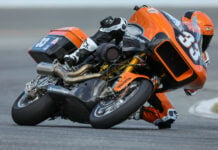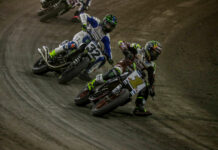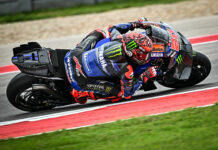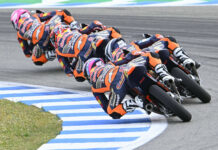A truly great grand prix motor cycle racing circuit in a superb location. They had been racing on the roads of the holiday Island, Phillip Island for many years but it was only when it was modified to it’s present day 4.448 kms configuration in 1988 that it gained international recognition. The track and facilities were completely re-vamped for grand prix motor cycle racing and the result was a circuit that is the favourite for the majority of the MotoGP stars. The track simply flows through a series of undulating bends finishing in a long downhill start and finish straight. The circuit staged the first Australian Grand Prix in 1989 and to the delight of the whole nation was won by Australian Wayne Gardner riding the Honda. Gardner won the next year but then the Australian Grand Prix venue was switched to Eastern Creek near Sydney. It returned to it’s original home in 1997 and has remained ever since. Alex Criville won the first 500cc race back at the circuit which has become the domain of Valentino Rossi. After winning the 250cc race in 1998 and 1999, the Italian has won the MotoGP race for the last four years, twice clinching the world title at the circuit. Max Biaggi won riding the Yamaha in 2000. Phillip Island, which is not really an Island and linked to the mainland by a bridge, is situated 100 kms south of Melbourne. The view from the start and finish straight over the choppy sea of the Bass Straight is almost as famous as the Penguin parade that has made the Island such a tourist attraction. The only drawback can be the weather. Often the rain and high winds can batter the Island in October but it’s a small price to pay for such a magnificent race track FROM THE SADDLE Alex Barros #4: “Phillip Island is a track I really like, it’s one of the best on the calendar; it’s fast, technical, with super-fast corners where the front of the bike is worked really hard, and as such has to be set up perfectly. So I hope that, with Michelin’s help after a week of being able to analyse the problems we have had in the last few races, we can get back to finding a good set-up between the tyre-forks combination. Compared to Qatar and Malaysia, Phillip Island will be a lot cooler, so conditions will be very different. We’ll see, I hope to have a good race.” Chris Vermeulen #77: “It’s especially exciting to be able to ride Honda’s RC211V at Phillip Island. It’s always good to ride at home because we only get one race there each year – nice to have friends and family there to support. Phillip Island is one of the best circuits in the world; it’s fast and flowing and that really suits my riding style. You get a great view of the ocean coming down the start-finish straight, but maybe I won’t get the chance to appreciate that so much on a factory Honda GP machine at something like 320kph! I’ve always struggled a bit on the two hairpins but that’s mostly because of the way I’ve had the bike set up. Because the rest of the circuit is so fast, there always has to be a bit of a compromise. Otherwise I love the place and Lukey Heights has to be one of my three favourite corners anywhere”. CIRCUIT – AUSTRALIAN GRAND PRIX – 16/10/05 PHILLIP ISLAND Track data: Length: 4.448 kms. Pole Position: Left. Width: 13 m Right corners: Five Left corners: Seven. Longest straight: 900 m Constructed; 1956 Modified: 2005 Pole setting lap record: Valentino Rossi (Honda – 2003) 1:30.068 – 177.785 km/h Record lap: Loris Capirossi (Ducati) 1:31.102 – 175.768 km/h. 2004 Race winner: Valentino Rossi (Yamaha) 41:25.819 – 173.925 km/h Alex Barros 2004. Barros fifth. TECHNICAL INSIGHT – AUSTRALIAN GRAND PRIX – 16/10/05 PHILLIP ISLAND TECHNICAL INSIGHT The average lap speed is 177.785 km/h, making it the second fastest track of the World Championship calendar behind Assen. This high speed would seem strange at a circuit with very few straights, however, although the main straight is relatively short at less than 900 metres long, the corner leading onto it and the corner at the end of it are both extremely fast corners taken at more than 180 km/h . The ideal settings would give the bike stability to be able to take the fast corners with as much precision as possible and use the maximum amount of track surface. There are six corners taken at over 180 Km/h and three of these are negotiated at more than 200 Km/h. Given the presence of these high speed corners, and the constant changes of direction at high speed, technicians tend to fit hard springs so that when the rear of the bike is under compression the riding precision is not affected and the rider can maintain the racing line through corners. However, the presence of many bumps on the track surface means that the springs to be fitted cannot be as hard as we would like. To demonstrate the pressure on the springs, the point of greatest compression of the rear of the bike takes place between corners seven and eight where the bike is travelling at more than 230Km/h. This speed creates a force of more than 500kg on the rear springs. Regarding the front suspension, the points in the circuit where there is most movement of the front shocks are the two hairpins taken at slow speeds. The rider must brake hard at these two points, but this is not a circuit where hard front springs are fitted because of hard braking. Due to the bumpy track surface in the fast corners, softer springs are fitted in the front to maintain the precision and the grip, even through these bumpy areas. Some of these bumps are so big that the bikes literally take off as they lose contact with the track in both the front and rear. The best place to witness this is at the end of the straight where the bikes leave the ground at more than 305 km/h. In Phillip Island the gear ratios are a little special since the higher gears are used more frequently than is usual. Most of the corners are taken in third, fourth and even fifth gear. These gears must be set so that there is not too large a step between them and also so that sixth can accommodate speeds of nearly 350 km/h. It is not always easy to find a good compromise. Unlike most other tracks in the MotoGP calendar, there are only two corners taken in first and two taken in second. Another special factor at Phillip Island is rear-tyre wear. As well as being a very abrasive track, the characteristics of the layout of the track put an excessive amount of stress on the rear tyre. The left side of the tyres is critical since the left-handed corner onto the straight is very fast and the rider can open the throttle early, and in doing so heating the left side of the tyre to temperatures that can affect the tyre’s durability. Sometimes we must sacrifice the rear suspension settings and make them softer to prolong the life of the rear tyre so that it lasts the race distance of 120 km. Another important aspect at this circuit is the front brake. There are no hard braking areas around the track so brake discs with smaller diameters are fitted so that they reach the correct working temperatures more easily. At Phillip Island discs of 305mm diameter are fitted compared to a normal diameter of 320mm.
© , Roadracing World Publishing, Inc.






